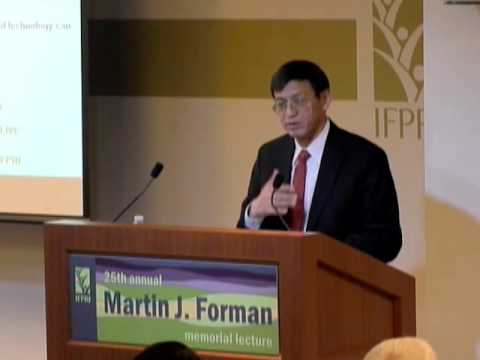For Rajiv Shah, former Administrator of the US Agency for International Development (USAID) and this year’s keynote speaker at the 25th annual Forman Lecture, the gravity of the global hunger problem was epitomized during a field visit to Somalia in the summer of 2011.
“It is extraordinary to me,” he said, “that at a time when the Famine Early Warning System (FEWSnet) and these other tools gave us the basic visibility to see this coming, we as a global community still suffered from the consequence of a famine where so many children—as many as 35,000—died because of a lack of access to food and basic nutrition during a drought that was predicted eight or nine months earlier.”
While acknowledging that the underlying causes of global hunger run deep, Shah asserted that the goal of ending hunger and malnutrition will remain elusive until we are able to provide more effective immediate humanitarian assistance during crises. One of the recommended measures he cited was to stop sending wheat, corn, and soy from the US and other developed countries during emergencies. Direct food aid, Shah argued, can negatively affect local commodity markets and, in some cases, even the health of the children it is intended to help.
A key part of the solution, according to Shah, involves embracing agricultural science and technologies that have a proven track record when it comes to combating hunger and malnutrition. He cited both electronic food vouchers and enhanced nutritional products as effective tools during humanitarian crises while also highlighting the benefits of biofortified crops for addressing long-term micronutrient deficiencies and drought-resistant crop varieties for mitigating the effects of global climate change.
Technology, however, is not a panacea. Policymakers and the global development community have to match bold rhetoric with real investments geared toward ending hunger and malnutrition. Shah praised the work being done by the USAID-led Feed the Future initiative, which has raised more than US$6 billion toward investing in female-headed smallholder farms through the promotion of nutritious and economically viable crop varieties in 19 target countries, the majority of which are located in Africa south of the Sahara. Feed the Future programs in Ethiopia, for example, have shown remarkable progress reducing rates of child stunting—up to 9 percent over three years. One key to Feed the Future’s success was linking the economic empowerment of women to both increased yields and improved nutritional outcomes, according to Shah.
In his welcome remarks, IFPRI Director General Shenggen Fan underscored the tremendous opportunity that the adoption of the UN Sustainable Development Goals (SDGs) last September affords the global development community. Fan cited the impact of strong national leadership in countries such as Bangladesh, Ethiopia, Malawi, and Rwanda toward reducing rates of hunger and undernutrition.
For his part, Shah heralded global advances toward reducing the prevalence of hunger and undernutrion but underscored that we are off track to achieve SDG1 (end poverty) and SDG2 (zero hunger) by the 2030 deadline. Even in the US, despite significant investments in social safety nets over the past several decades, Shah revealed that an estimated 15.3 million children live in a condition of chronic hunger and malnutrition. “In order to be able to lead an effort to address hunger and poverty at a global scale, we need a better and renewed sense of what success looks like,” Shah said. “Reinventing the American food system in country after country may not generate the long-term gains in ending hunger and malnutrition that we seek.”
Ultimately, Shah sees efforts to fight hunger and malnutrition as “the first leg in a broader fight for development, economic prosperity, and justice around the world for vulnerable populations.” This is as true for the malnourished child in the US as it is for the starving child facing drought-induced famine in Somalia. “This is a moral task of making sure that no one has to suffer this way,” Shah remarked.







